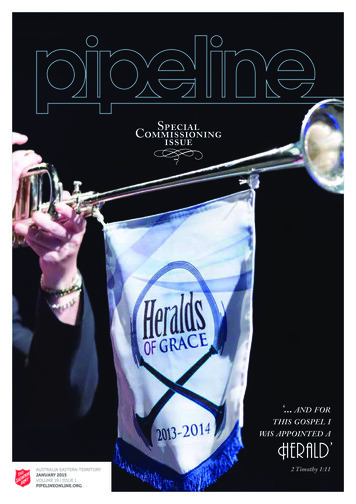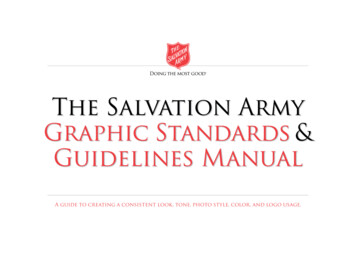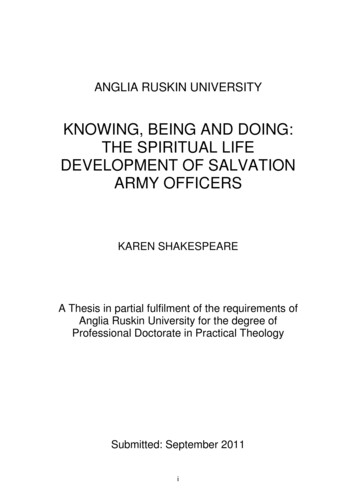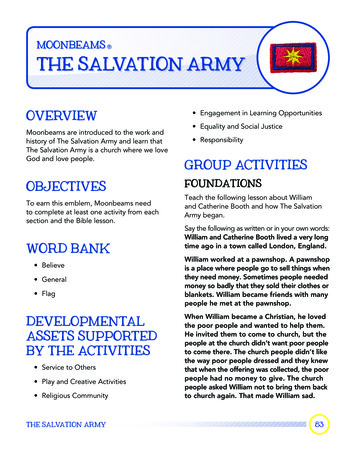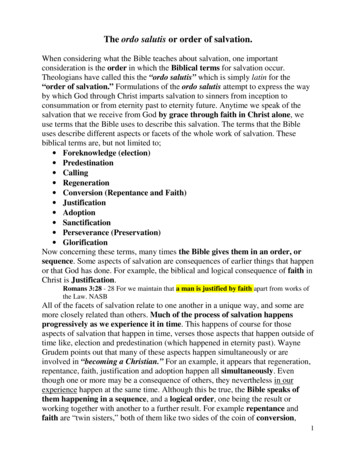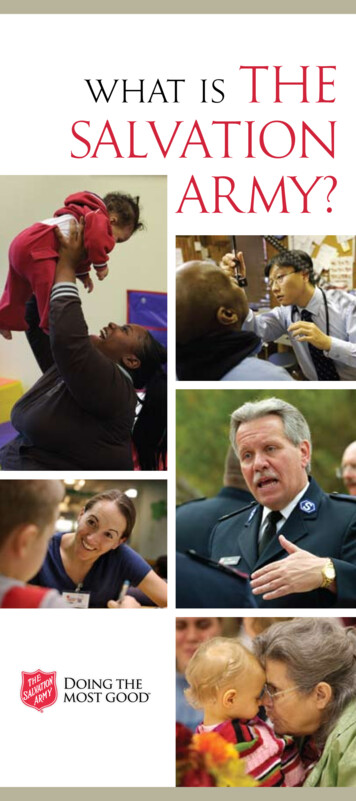
Transcription
THEsalvationarmy?What IS
The Salvation ArmyMissionS tat e m e n tThe Salvation Army, an internationalmovement, is an evangelical partof the universal Christian church.Its message is based on the Bible. Its ministryis motivated by the love of God. Its missionis to preach the gospel of Jesus Christand to meet human needs in His namewithout discrimination.Approved by theCommissioners’ Conference, USAMay 19913
forewordThis booklet provides a brief overview ofThe Salvation Army and answers many fre-quently asked questions. It is presented with anearnest prayer for guidance as we worship Godand serve the needs of others.Today, the Army’s religious and social-serviceactivities serve millions of men, women andchildren in more than 108 nations around theworld. Volunteers, contributors and other supporters make those services possible in localcommunities.William Booth began The Salvation Army inJuly 1865, preaching to a small congregation inthe slums of London. With the military spirit ofa professional soldier, he battled bravely againstalmost overwhelming enemies: debasing poverty,biased public policy, ignorance, addictions, sinand despair.Booth’s undaunted spirit attracted local followers whose numbers grew over the years.Thirteen years later, The Salvation Army becamea legal entity with a military structure.4
historyFounder William Booth and his daughter, EvangelineWilliam Booth embarked upon his ministerial career in 1852, desiring to winthe lost multitudes of England to Christ. Hewalked the streets of London to preach thegospel of Jesus Christ to the poor, the homeless, the hungry and the destitute.Booth abandoned the conventional conceptof a church and a pulpit, instead taking his message to the people. His fervor led to disagreementwith church leaders in London, who preferred5
traditional methods. As a result, he withdrew fromthe church and traveled throughout England, conducting evangelistic meetings.In 1865, William Booth was invited to hold aseries of evangelistic meetings in the East End ofLondon. He set up a tent in a Quaker graveyard,and his services became an instant success. Thisproved to be the end of his wanderings as anindependent traveling evangelist. His renownas a religious leader spread throughout London,and he attracted followers who were dedicated tofight for the souls of men and women.Thieves, prostitutes, gamblers and drunkardswere among Booth’s first converts to Christianity.To congregations that were desperately poor, hepreached hope and salvation. His aim was to leadpeople to Christ and link them to a church forfurther spiritual guidance.In 1867, Booth had only 10 full-timeworkers, but by 1874, the number had grownto 1,000 volunteers and 42 evangelists, allserving under the name “The ChristianMission.” Booth assumedthe title of general superintendent, with his followerscalling him “General.”Known as the “HallelujahArmy,” the converts spreadout of the East End ofLondon into neighboringareas and then to other cities.William Booth6Booth was reading apens the words,printer’s proof of the 1878“The Salvationannual report when heArmy,” unknowinglynoticed the statement, “Theestablishing aChristian Mission is a vol-new name for theunteer army.” Crossing outorganization.the words “volunteer army,”
Early Salvationists were subjected to violence and ridicule.Publications of the day, such as this 1885 issue of Puck, pokedfun at their uniforms and methods.he penned in “Salvation Army.” From thosewords came the basis of the foundation deedof The Salvation Army, which was adopted inAugust of that year.From that point, converts became soldiersof Christ and were known then, as now, asSalvationists. They launched an offensivethroughout the British Isles, against the “sevendark rivers” of evil: grinding poverty, disease, lust,crime, war, despair and atheism.The Army also gained a foothold abroad.Lieutenant Eliza Shirley had left England to joinher parents, who had immigrated to Americaearlier in search of work. In 1879, she held thefirst meeting of The Salvation Army in America,in Philadelphia. The Salvationists were receivedenthusiastically. Shirley wrote to General Booth,begging for reinforcements. None were available at first. Glowing reports of the work inPhiladelphia, however, eventually convinced7
Commissioner George Scott Railton and seven Hallelujah Lassiesofficially “opened fire” in the United States on March 10, 1880.Booth, in 1880, to send an official group to pioneer the work in America.On March 10, 1880, Commissioner GeorgeScott Railton and seven women officers knelton the dockside at Battery Park in New York Cityto give thanks for their safe arrival. At their firstofficial street meeting, these pioneers were metwith unfriendly actions, as had happened inGreat Britain. They were ridiculed, arrested andattacked.Three years later, Railton and otherSalvationists had expanded their operationinto California, Connecticut, Indiana, Kentucky,Maryland, Massachusetts, Michigan, Missouri,New Jersey, New York, Ohio and Pennsylvania.8
President Grover Cleveland received a delegation of Salvation Army officers in 1886 and gavethe organization a warm personal endorsement.This was the first recognition from the WhiteHouse and would be followed by similar receptions from succeeding presidents.The Salvation Army movement expandedrapidly to Canada, Australia, France,Switzerland, India, South Africa, Iceland andGermany. Currently, the United States is hometo more than 8,500 centers of operation andlocal neighborhood units. The Salvation Army isactive in virtually every corner of the world.The Salvation Army National Archives and Research CenterA 1919 Salvation Army Home Fund Campaign poster9
PurposeThe purpose of The Salvation Army issuccinctly stated in its mission statement:The Salvation Army, an international movement, is an evangelical part of the universalChristian church. Its message is based on theBible. Its ministry is motivated by the love ofGod. Its mission is to preach the gospel of JesusChrist and to meet human needs in His namewithout discrimination.The vision of The Salvation Army has alwaysbeen to lead men and women into a properrelationship with God. The Army recognizesthat a physical, emotional and social restorationmust go hand in hand with spiritual rebirth.The Army practices an integrated ministry,uniting spiritual, social and physical support.Social-service programs are a practicalexpression of the dominating spiritualmotivation of The Salvation Army. Aid is givenwherever and whenever the need is apparent,without distinction as to race or creed. Thereare no demands for adherence, simulated or real,to the principles of The Salvation Army.“Inasmuch as ye have done it unto one of the leastof these My brethren, ye have done it unto Me.”—(Matthew 25:40, King James Version)10
structureThe United States is divided into four territories, with headquarters in Des Plaines,Illinois; West Nyack, New York; Atlanta,Georgia and Long Beach, California. Eachterritory is a corporation and has its own commander, holding the rank of commissioner.The National Commander and national chiefsecretary serve in coordinating capacities atThe Salvation Army National Headquarters inAlexandria, Virginia.Each territory operates under the broadgeneral policies established by InternationalHeadquarters. National USA policies are established by the Commissioners’ Conference, com-posed of all active commissioners serving atNational Headquarters or in any of the territoriesin the USA, the national chief secretary and therespective USA territorial chief secretaries, andpresided over by the National Commander. Thisstructure permits local leadership to respond toconditions and needs in each community, whilemaintaining unity on overall policies.The basic service unit of The SalvationArmy is the corps community center. Some11
Officers become an integral part oftheir communities, seeking solutionsthat reflect local needs.cities may have several centers. They provide avariety of local programs, ranging from religiousservices and evangelistic campaigns to familycounseling, day-care centers, youth activitiesand general programs. The religious and socialservices implement the Army’s purpose ofpreaching the gospel to effect spiritual, moraland physical reclamation. The corps community centers within defined geographical boundaries comprise a division, with 40 divisions inthe United States responsible to their respectiveterritorial headquarters. Specialized social workis conducted through adult rehabilitation centers within these divisional commands.ADVISORY ORGANIZATIONSAdvisory organizations provide valuable assistance and advice. Local community leadersvolunteer their efforts to help the Army in maintaining good business and professional relations.Local advisory boards review annual budgets,help coordinate programs with other agencies,and provide advice for local activities and fundraising campaigns. Other advisory organizationsserve specific Salvation Army programs in similarways. A National Advisory Board, for instance,provides guidance for programs and servicesthroughout the United States.VOLUNTEERSVolunteers from all walks of life strongly support The Salvation Army in almost all of itsactivities. Their time and commitment are12
essential to the success of the organization. Themillions of volunteers who function as partof the Army’s ministry each year enhance theeffectiveness of Army programs and services.The Salvation Army owes its strength ofservice to the diversification of programs. Mostof these programs are designed to involvecommunity volunteers effectively to meetcommunity needs.officers& SoldiersOperations of The Salvation Army aresupervised by trained, commissionedofficers who proclaim the gospel and serve asadministrators, teachers, social workers, counselors, youth leaders and musicians. These menand women have dedicated their lives, skillsand service completely to God. Lay members who subscribe to the doctrines of TheSalvation Army officers dedicate their careers to serving andleading in their communities.13
Salvation Army are called soldiers. Along withofficers, they are known as Salvationists.Candidates for officership undergo an intensive, two-year course in residence at SalvationArmy colleges in Chicago; Suffern, New York;Atlanta; and Rancho Palos Verdes, California.The curriculum combines theory and fieldpractice, including Salvation Army doctrine,sociology and social work, psychology, SalvationArmy regulations, homiletics, public speaking,Bible studies, church history, composition,community relations, business administration,accounting, and vocal and instrumental music.After two successful years of training, cadetsare commissioned as lieutenants, ordained asministers, and assigned to active duty whilecontinuing their education. Lieutenants arerequired to devote five years to additionalstudies. Numerous advanced training coursesare available for officers wishing to specialize ina particular discipline. Institutes, seminars andconferences have been established to ensurethat officers are informed of new and innovative programs and developments.Promotion is based on length of service,character, efficiency, capacity for increasedresponsibility and devotion to duty. The ranksare lieutenants, captain, major, lieutenantcolonel, colonel and commissioner. The international leader holds the rank of general and isselected by a high council of active-duty commissioners and territorial commanders.Salvation Army officers must devote full timeto Army work. An officer who marries mustmarry another Salvation Army officer or leavehis or her officer status. Married lieutenants, captains and majors will individually carry the rankapplicable to their own length of service, not14
that of their spouse. In the case of married officers, the conferred ranks of lieutenant colonel,colonel and commissioner will be held jointly. Asordained ministers of the gospel, they are authorized to perform marriage ceremonies, funeralservices and infant dedications. They also providecounseling and consolation to the bereaved.The Army also employs lay personnel in manyclerical, technical and professional posts.ServicesINDIVIDUAL REHABILITATIONAdult rehabilitation centers are among themost widely known of all Salvation Armyservices and comprise the largest residentrehabilitation program in the United States.Individuals with identifiable and treatableneeds go to these centers for help when theyno longer are able to cope with their problems. There they receive adequate housing,nourishing meals and necessary medical care,and they engage in work therapy. They alsobenefit from group therapy, spiritual guidanceand skilled addictions counseling in clean andwholesome surroundings. Residents may bereferred or be remanded by the courts.Salvation Army programs offer a chance for people torebuild their lives.
Donated material, such as furniture, appliances or clothing, provides both needed worktherapy and a source of revenue through theArmy’s thrift stores. More than 100 adult rehabilitation centers offer these programs in theUnited States.EMERGENCY HOUSINGFree temporary shelter is available to homeless men, women, children and families insevere financial need. Low-cost housing also isavailable to men and women living on pensionsor social security.WOMEN & CHILDRENEfforts toward the rehabilitation of menare paralleled by aid to women andchildren. These services usually are providedat the local level, since The Salvation Armymeets needs as they are identified withinspecific localities. In some areas, the needfor both transitional housing and HIV/AIDScounseling occurs on a daily basis.Outpatient care, aftercare for the young motherand counseling are helping to lessen repeatedunwanted pregnancies. In order to restore youngmothers to a productive place in society, somecenters provide group therapy, vocational guidance, special high-school classes and day-carewhile mothers work.Other major programs and facilities offeredinclude emergency shelters, medical andcounseling services for women suffering fromsubstance abuse, homes for pre-delinquentadolescent girls, and children’s homes. Daycare centers throughout the country maintainhigh standards of service, offering childrenwholesome food and affectionate care, as well16
Family programs respond to local needs with dedicated, caring staff.as activities designed to promote their physical,mental and spiritual growth and well-being.Education for parenthood projects is conductedfor teenagers. Foster homes and adoption services are available in many communities.HUMAN TRAFFICKINGThe Salvation Army is actively involved infighting against this international crimeagainst human rights and in providing services for victims. It is estimated that nearly 1million people are sold across internationalborders each year, having been bought andtransported in slave-like conditions for sexand labor exploitation.COMMUNITY DEVELOPMENTThe Salvation Army is stretching its "handout to man" ministry to include additionalprograms for housing, employment, and community development.17
ADVOCACYThe Salvation Army affirms the necessaryinvolvement of its personnel in facili-tating change at the personal level, as well aseffecting strategies that assist in shaping publicpolicy. Public-policy changes can then lead toimproved services, access and opportunity forthose whom the Army serves.The biblical message of salvation impliesabhorrence for every form of alienation,oppression and discrimination.The Salvation Army is committed to meeting both practical andspiritual needs.YOUTHn increased emphasis has been placed on youthactivities for many years. Each corps community center has religious and character-buildingprogramming for young people. Among theactivities are: Sunday school, troop-type programming for boys and girls, skill-building in a recreational setting.Music classes, athletics, arts and crafts, andcamping offer opportunities for developingspecial talents and skills.18
Many youth programs, such as communitycenters and boys and girls clubs, have both fulltime professional leadership and volunteers.FAMILYFamily services endeavor to strengthen andunify the family unit, whether it is a tradi-tional two-parent family, a blended family ora household led by a single adult. Emphasisis placed upon the importance of the familyworshiping together.Program services are constantly expanding andinclude financial assistance, counseling and casework services when necessary. Counseling assistswith child-parent relationships, marital problems,adolescent problems, unmarried mothers’ situations and unemployment. Christmas activities andsummer-camp holidays are planned, along withhelp for everyday family life.CorrectionsThrough cooperative arrangements withprison, probation and parole officialsthroughout the country, The Salvation Armyplays a growing role in prison rehabilitationand crime prevention. In some jurisdictions,prisoners are paroled to the direct custodyof The Salvation Army. Services includeBible correspondence courses, prerelease jobtraining programs, employment opportunitiesin cooperation with parole personnel, materialaid and spiritual guidance for both prisonersand their families.Community-based rehabilitation is providedin centers. Many Salvation Army rehabilitationcenters and Harbor Light Centers serve as designated halfway houses, where former prisonerscan participate in work-release programs. Those19
convicted of minor offenses often are given theopportunity to accept placement in communityservice programs at corps community centers andinstitutions as an alternative to incarceration, or inthe last months of their sentences.In addition, Salvation Army officers andvolunteers lead worship services in jails andprisons. Counseling and emergency assistancealso are available to crime victims and/or families of those incarcerated.ANGEL TREE PROGRAMThe Salvation Army's Angel Tree Programprovides new clothing and/or toys forchildren. A sponsoring company or corporationplaces a Christmas tree in a secure, high-pedestrian traffic area or lobby. The tree is decoratedwith numbered paper angel tags with the firstname, age and gender of a child who will receivethe gift. Contributors remove one or more tagsfrom the tree and purchase appropriate gifts forSummer camps givechildren an opportunityto experience muchmore than fresh air.the child or children describedon the tags. The toys are thendelivered to the unit and laterpicked up by the parent to distribute to the child/children onChristmas Day.Summer campsThousands of children fromlow-income families enjoyfresh air, exercise and newfriendships at annual summercamp programs. The campingexperience is more than justa pleasant vacation. Childrenlearn new skills and self-reliance; trained counselors who20
understand their emotional needs and problemshelp them to mature.Contact continues after the children returnhome. Often, entire families receive benefits fromthese camping experiences through expandedservices. Seniors also find recreation and refreshment at camp sessions. Many camps have beenwinterized for year-round use by groups.The Salvation Army provides holiday assistance to more than4 million persons annually.christmasThe “miracle” of Christmas is repeated overand over again through the joy of caring andsharing. The traditional red kettle is an integralpart of the Christmas scene, with millions ofdollars donated each year to aid needy families,seniors and the homeless, in keeping with thespirit of the season.Donations provide Christmas dinners, clothingand toys for families in need. Financial assistancealso helps with basic necessities, along with seasonal aid. Families of prisoners often are included.Volunteers distribute gifts to shut-ins inhospitals and nursing homes, and shelters areopen for sit-down dinners. The Salvation Army21
Salvation Army disaster teams stand ready to respond at a moment’s notice.endeavors to bring spiritual light and love tothose it serves at Christmas so that the realmeaning of the season is not forgotten.Many families receive aid over a period ofmonths after the Christmas season as well—people struggling with difficult family, emotional or employment problems.emergencies & DisastersDisasters come in many forms, both natural and manmade—always devastatingto those involved. The Salvation Army isalways on the scene because of its everydaypresence in communities across the country.With that constant awareness of people’sneeds, The Salvation Army is often among thefirst on the scene when disaster strikes. Officersare trained to meet all kinds of emergencies byproviding food, shelter, clothing and spiritualcomfort. Disaster canteens have become familiarsights to firemen, policemen and victims alike.Hot and cold drinks, soup, sandwiches, andcomplete meals fill vital needs when homes are22
destroyed and people are hungry.The Salvation Army works with emergencymanagement personnel and many other organizations to form a cooperative team during suchdifficult times. Each year, millions of volunteerscome forward during disasters to give theirtime and effort when it is needed most.missing personsSeeking missing persons is an internationalservice provided by The Salvation Army.Cases are accepted for search in all parts ofthe world. Within the United States of Americamissing persons services are provided in theEast and West territories. All other requestsare referred to International Headquarters.Thousands of men and women have beenreunited with their families.league of Mercy/community care ministriesThe League of Mercy/Community CareMinistries provides a listening ear, a caringheart and a helping hand. With these simpletools, the men, women and youth volunteersassist individuals in their personal battles withloneliness, illness, sorrow and suffering.They visit hospitals, convalescent and nursinghomes, correctional facilities, veteran’s medicalcenters, children’s homes, and the homebound.They share a personal item (writing materials,magazines such as The War Cry, refreshmentsor a Bible), and also a gentle touch and a heartfelt “God bless you” with each person.Members endeavor to follow Christ’s injunction: “Inasmuch as ye have done it unto one ofthe least of these my brethren, ye have done itto me” (Matthew 25:40).23
SeniorsToday the 55-plus age category is thefastest-growing group in the country. Thismakes The Salvation Army programs for olderadults more important than ever.Each year thousands of older adults areserved by The Salvation Army. In corps community centers throughout the nation, older adultsgather to share interests, develop new skills andenjoy the company of their peers. The SalvationArmy meets their needs in many ways.ActivitiesEducational classes, day care, hot-lunch programs and pre-retirement seminars are justa few of the programs the Army offers. Eachcenter provides a variety of activities to meetdiverse needs. Here, in an atmosphere ofunderstanding and respect, new friendshipsare formed and talents discovered.Programs for seniorsSenior Campingoffer recreationOlder adults also enjoy theand fellowshipbeauty of God’s great outdoors.opportunities.Many Salvation Army camps areadapted to meet the physicalneeds of older adults. Clean,comfortable, easy-access campfacilities allow older adults anouting for the weekend or toenjoy week-long programs. HereGod works His miracles ofphysical, emotional and spiritualrenewal in the open air.Army ResidencesThe Salvation Army operatesseveral residential facilities for24
older adults. Here older people can live in anatmosphere of love, acceptance and encouragement. There are also several adult day-careservice centers for those seniors who needspecialized services.community service clubsIn many communities, The Salvation Armyoperates active men’s fellowship clubsthat provide service programs. Men meet fordinner meetings to plan community-serviceprojects, special events and weekend retreats.They enjoy fellowship, music and speakers.the armed forcesService to American armed forces beganduring the Spanish-American War, whenSalvation Army officers accompanied troopsto the Philippine Islands. In 1917, NationalCommander Evangeline Booth initiated a program that ministered to the needs of Americanmilitary men at home and abroad. In theprogram, female Salvationists became knownas “Sallies” as they served donuts and coffeein the frontline trenches and elsewhere. Theybecame a symbol of love and caring that hasendured through the years.In 1939, as World War II appeared inevitable,The Salvation Army helped create the interfaithmovement that led to the formation of theUnited Service Organization, known as USO.service unitsService extension programs are availablewhere no established corps communitycenters exist. These units work with committees of local citizens to identify and meet community needs, and to network with statewide25
and interstate Salvation Army programs.Services range from medical and dental assistance to sending children to summer camp orsupplying gasoline, food, and clothing to theneedy. Service units provide individual andemergency services according to general policiesand the decisions of local committees.world servicesThe Salvation Army World Service Office(SAWSO) meets the challenges of its mis-sion on a daily basis: SAWSO supports andstrengthens the Salvation Army’s efforts to workhand in hand with communities to improvethe health, economic and spiritual conditionsof the poor throughout the world. Establishedin 1977, SAWSO specializes in the areas ofcommunity health; HIV/AIDS; food security,water and sanitation; microfinance; internationalanti-human trafficking and disaster relief andrestoration. With a small staff, SAWSO leverages its impact through The Salvation Army’sworldwide network of churches, men’s andwomen’s fellowship groups and communitycare ministries.SAWSO embraces community-driven solutions that improve living conditions; raise skilllevels; increase productivity; and create community-wide participation for long-term development. This is accomplished by providing ourlocal partners with technical expertise and facilitation of workshops on project design, planning,management, leadership and community development. Funding comes from both public andprivate sources. Visit our website for more information about our work and outreach as well asto learn how you can be involved: www.SAWSO.org.26
salvationThe SalvationArmy wasfounded as an evangelical organizationdedicated to bringingpeople into a meaningful relationshipwith God throughChrist. Its doctrinalbasis is that of theWesleyan-Arminiantradition. It is composed of personswho are united bythe love of Godand man, and whoshare the common purpose of bringing othersto Jesus Christ. The word salvation indicatesthe overall purpose of the organization—tomotivate all people to embrace the salvationprovided to them in Christ.The word army indicates that the organization is a fighting force, constantly at warwith the powers of evil. Battles are effectivelywaged through an integrated ministry thatgives attention to both body and spirit. It is atotal ministry for the total person. The Armycooperates with churches of all denominationsto meet the needs of the community.Those who have drifted away from God andthose estranged from their own religious affiliations are often attracted to The Salvation Army.They are first urged to seek Christ for pardonand deliverance from sin. Then they are encour-aged to return to active membership in their27
own churches or to enroll as soldiers in a corpscommunity center. Young people often areattracted through local music groups, youthcamps and recreational centers.active ServiceChristianity is synonymous with servicefor the Salvationist. The distinguishingfeature in the religious life of The SalvationArmy is active participation by its members.Corps community centers are the focus of thespiritual work and are organized in a militarymanner, using military terms throughout.The corps building is sometimes known asthe “citadel.” The pastor serves as an “officer.”Members are “soldiers.” This sphere of activityis known as the “field.” Instead of joining TheSalvation Army, members are “enrolled” aftersigning the “Articles of War.” When officers andsoldiers die, they are “Promoted to Glory.”Soldiers are disciplesof Jesus Christ and areexpected to accept responsibility in the work of TheSalvation Army. Wheneverpossible, they participatein Army meetings. Soldiersmay teach Sunday-schoolclasses, play musical instruments, join the band, assistthe corps officer in visitation among the poor andsick, or aid in general socialMusic has always been a keywork. Soldiers abstain frompart of The Salvation Army’sthe use of alcoholic bever-worship and fellowship.ages, drugs and tobacco.28
musicMusic has been an important part ofreligious life in The Salvation Army.Throughout its history, music has symbolizedthe cheerful religion of Salvationists, providingboth the expression of a joyous faith and aform of recreation. Many officers and soldiersplay musical instruments and participate ininformal musical sessions.Bands and songster brigades (choirs) are recognized for their achievements and often arecalled upon to participate in community activities. Famous conductors and composers havecommended Salvation Army bands for theirmusical excellence. The list includes John PhilipSousa, Ralph Vaughan Williams, Edwin FrankoGoldman, Erik Leidzen, Meredith Willson, Dr.Rudolph Ringwald and others. Many prominentmusicians throughout the world have receivedtheir music training in The Salvation Army.worship meetingsEvery corps community center designatesspace for weekly congregational worshipservices led by Salvation Army officers, whoare ordained ministers. Responding to the spiritual needs o
The Salvation Army movement expanded rapidly to Canada, Australia, France, Switzerland, India, South Africa, Iceland and Germany. Currently, the United States is home to more than 8,500 centers of operation and local neighborhood units. The Salvation Army is active in virtually every corner of the world. A 1919 Salvation Army Home Fund Campaign .


